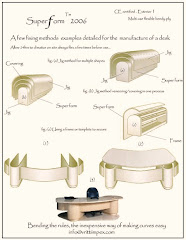



This continues on the idea of the Commuter power boat,this design is not complete,its a proposal for a craft sized forty feet long and ten feet wide,with nothing cast in concrete as fas as the sizes are concerned,we know this type of craft has a future as a weekender but also as a retirement home.
Justin comments:
Hi Roy - been entertaining myself with this concept of a 40ft powercruiser.
Long and thin - I think she will be quite agile and easy to build in hard chines, with a box keel.
Selling points would be:
Economical to build and operate
Offers a lot of accommodation for her size. Two versions are shown - one has an extra aft cabin for guests/chartering.
Traditional looks
Ideal for Med, European rivers, and Intra-coastal waterway.
Long range - about 2-4 k n.m depending on tankage.
Quite comfortable for a motor cruiser - limited rolling.
Light and airy saloons
Very quiet underway It wouldn't be hard to make this boat unsinkable and fully self-righting. Need to do the tricky work on hulls etc before I can prove this though
I also suspect she would sail suprisingly well off the wind with the features of a sharpie (allowing for limited reserve stability, small rudder and large fixed prop). Though this is not the design objective at all . . .
Cheers The "40' Light Cruiser" was conceived as a yachtsman's alternative to a sailboat for cruising grounds in the Med, Baltic, perhaps the West Coast of Scotland -alternatively the Intra Coastal Water way, the Caribbean or similar. She is intended as a very economical displacement boat, capable of 6-7 kts on a single economical 50Hp engine. Sketches shown are concept drawings for a a simple and easily constructed hull. The hull form is not finalised yet, but will be based on an advanced sharpie concept, with a box-keel, and moderate deadrise. This will keep the weights very low, for good reserve stability and reduced rolling, while allowing the engine to be sunk low into the keel, with a near-horizontal shaft angle. The keel itself will be metal-plated below allowing grounding and shoal draft cruising. While most economical at hull speeds, this type of hull-form can easily be moved at semi-displacement speeds of up to about 20 kts without much bother, but initial design intention is purely for economy, safety, ease of construction, and low cost.
Normally, this design brief results in a light trawler boat concept. However, it is intended the sharpie hull will offer simpler construction, lower cost, better looks, less windage etc. Possibly less rolling too but this needs to be assessed once a design is available.
Compared with a sailboat, the advantages of this kind of vessel include:
- ideal for rivers, bridges, canals, and shoal-draft estuaries etc
- allows voyaging in ideal weather conditions (don't have to wait for the wind)
- easy short-handed cruising (retired couple)
- easily beached or grounded on box-keel for maintenance
- ability to see out through cabin windows at eye-level
- low cost of construction (no rig or keel required)
- easily stored on land in hurricane season (low and flat)
- easily constructed in marine ply with no complex curves
Sharpies of this nature start to make sense at 40' LOA. Due to their flat underbodies, sufficient headroom is not easily achieved on shorter vessels, unless they become very high and slab-sided. At 40' (perhaps 39' for licensing reasons and mooring costs) - they start to offer generous accommodations, excellent cruising range, and ride comfort.
Principle dimensions:
LOA 40'
Beam 10'
Fuel Tankage - 1000 litres
Power - 50Hp diesel inboard driving a single slow turning 18' prop
Cruising speed 6-7 kts
Range - 2k n.m. with some reserve.
Displacement (loaded) est. 6000 Kg
Justin




No comments:
Post a Comment